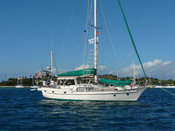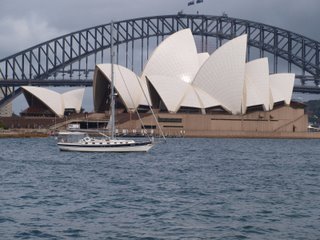Tackless II featured in LATITUDES & ATTITUDES Magazine
South Pacific Blog
Tackless II's Home Page & Website
Gwen's Admiral's Angle Column
Women & Cruising Website
Jimmy Cornell's Noonsite
Seven Seas Cruising Association
Australia's Weather Site
Victoria University's S. Pacific Weather Site
Australian History
March 11-20, 2009 – Part One--The Two Captains Bec...
2 C Camping Update March 18 2008
10 March 2009 -- What the 2Cs Have Been Doing wit...
Tackless II is for Sale
090212 - The Tragic Fires in Victoria
February 5, 2009 – Adventuring in Coffee Land
February 1, 2009 - Sunday Drive
January 26, 2009 – Australia Day
24 January 2009 -- On the Subject of Dogs
It was another visit to Procyon that has us on our way to Sydney. She was moored at Cammeray Marina in North Sydney (33*.49'S;151*.13'E), (Marina is at bottom center of the photo which is looking south to the city)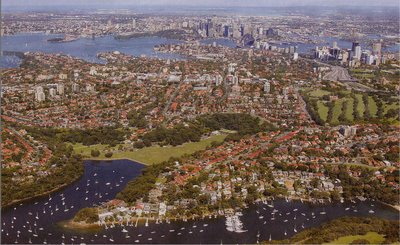
and we had plans to celebrate Sheri's 50th birthday and take in a Christmas concert at the Sydney Opera House on the 19th. In between, we hoped to see as much of the great city as we could.
The coast of New South Wales around Sydney looks from the air (and the map) to be one long series of deep bays and estuaries pushing way back into the continent, of which Sydney Harbor is just one. Sydney Harbour itself is home to countless coves and backwaters, most all of which are packed with boats at anchor, on moorings or in slips. We flew right over the fjord-like Cammeray inlet on our approach, and what surprised me was how hilly the land was. I don't know why I was surprised; Randy and Sheri had warned us of the 107 steps to reach the street from the marina.
Sydney's Airport is right on Botany Bay, allowing tourists to land at the very spot James Cook did in the Endeavor back in 1770. At the airport we bought green passes that would allow us unlimited use of the city's trains, busses and ferries and promptly climbed on the train that would carry us into to Wynyard Station in the city center. There we exited the underground to catch the bus to Cammeray. It was an easy, organized connection even though we'd managed to arrive at rush hour. Having just missed the rush hour express bus, we took about twenty-five minutes on the local across the famous Sydney Harbour Bridge (from which you can look down onto the Harbor and the Opera House) and through the neighborhoods of Neutral Bay to reach our stop where Randy and Sheri were waiting for us. The marina was about five blocks away, its unassuming sign and stairway down squeezed between very upscale houses.
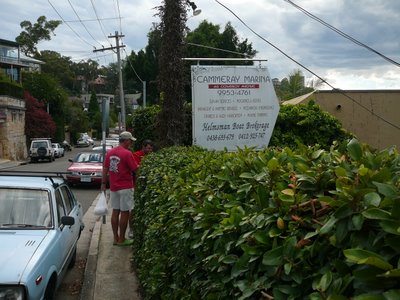
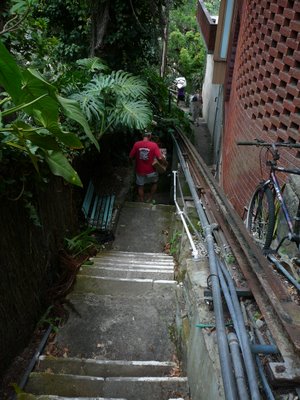
Cammeray marina is a relic. The docks and slipway (it is actually a boatyard) has been in existence over a hundred years, predating a lot of the fancy houses squeezed onto the hillside. Seemingly out of the way, it actually is a well-known center for the sailing community, and two of the boats on the dock were preparing themselves for the famous Sydney Hobart race coming up soon on Boxing Day. It is a beautiful spot, and thanks to a golf course above the northern shore in Northbridge the bay retains a natural look. There are lots of birds, including a flock of cockatoos who could sustain an amazingly annoying chatter.
We took it easy the first night, enjoying a lovely dinner assembled by Sheri and grilled by Randy. I believe I have described Procyon before, but, briefly, she is the owner's version of a Gozzard 44, meaning her whole interior has been conceived for one couple. That means that visitors like us sleep in the forepeak salon. However, the area converts ingeniously to a guest berth by sliding the seats of the couches together on top the coffee table, and privacy is created by raising a folding divider to cover the pass-through to the breakfast nook and galley.
The next day, Sheri's B-day started with champagne and omelets. Then we hit the tourist trail, retracing our steps to the bus to Wynyard. From Wynyard we were heading for the famous Manly Ferry when Sheri took a sudden detour into a chocolate café. Well, she was the birthday girl and we were honor-bound to indulge her, especially as it was just about the right time for second breakfast. I sure wish I could remember the name of the place, because it was a revelation. Sheri ordered chocolate dipped strawberries to share and a hot chocolate, I had a decaf mocha made with dark chocolate, Don got a sinful brownie and Randy had a chocolate shot! Who knew you could do such decadent stuff!
We reached Sydney's famous Circular Quay just in time to walk onto the Manly Ferry. 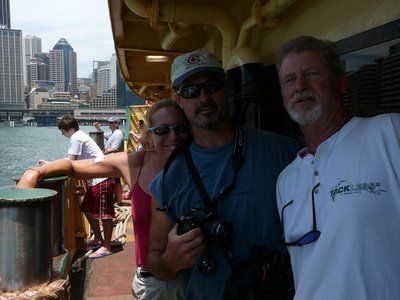

We rode standing on the side decks and bow drinking in all the iconic sights: the bridge, the Opera House, North and South Head, and all the scenic bays and coves in between. 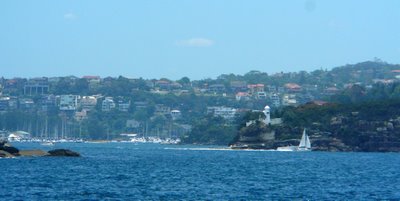

Sydney is huge! It's metropolitan population of over 4.2 million sprawls over more than 600 suburbs and 2,500 square kilometers, most all of which are oriented to the water, either the coves of the harbor itself or its oceanfront beaches.
Manly Beach is one of these. Situated near the North Head of the entrance into Port Jackson (aka Sydney Harbor), the ferry docks on one side of a narrow isthmus while beach itself is on the other. In between is a shopping street of galleries and surf shops.
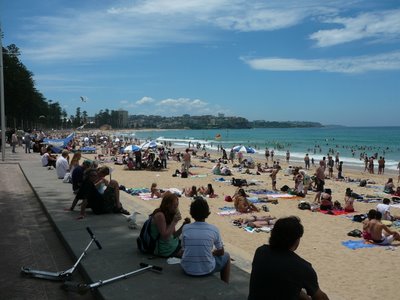
Packed with bathers, the beach is a long curve backed by a tree-studded esplanade and the 9 km long scenic walkway leading to the top of North head. We were headed along the walkway when I realized I had left my Admirals' Angle ball cap at the pub where we'd stopped for a beer. Fortunately it was rescued by another cruising couple from the boat Larissa!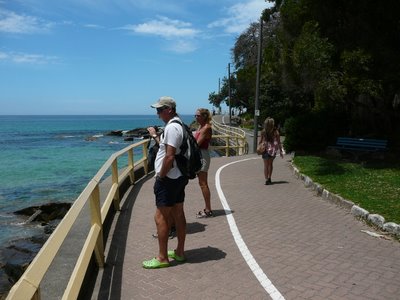
For her birthday dinner that night, Sheri had picked a steak house in Neutral Bay. Imagine our disorientation when, after picking out four expensive steaks (distinguished on the menu by cut, state of origin and how it had been fed), our baked potatoes and salads, the meat arrived cold with tongs and we had to grill it ourselves! All in all it was pretty much like an urban version of Musket Cove. However, the results were outstanding. Can't argue with that!
For our second day of playing tourist, we chose Darling Harbor as a destination. Darling Harbor is a deeply inset bay west of the Harbour Bridge whose waterfront is lined by commercial wharves and upscale tour boats. At the innermost end is Cockle Bay which has been developed for tourism. Our first stop, on the east side of the bay, was the Chinese Garden of Friendship. 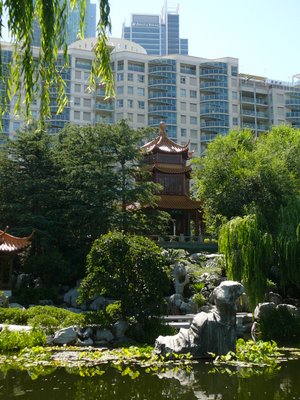
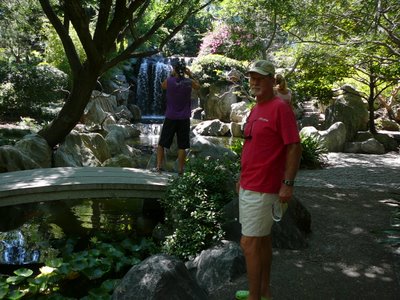
Built in honor of Australia's Bicentenary in 1998, the garden works a miracle in blotting out bustling downtown in favor of dozens of small water and rock garden-scapes all knitted together with pavilions and paths, streams and waterfalls, flowers and bamboo. Every corner is a charming space, every angle a soothing view. At the end of the path is a teahouse where (for today's second breakfast) Sheri and I had dim sum and tea while the boys had pastry and coffee.
On the west side of Cockle Bay is a huge convention center, a strip of boutique restaurants and the Maritime Museum. Walking around, we passed a stair-stepped circular reflecting pool and sveralvery unusual fountains.
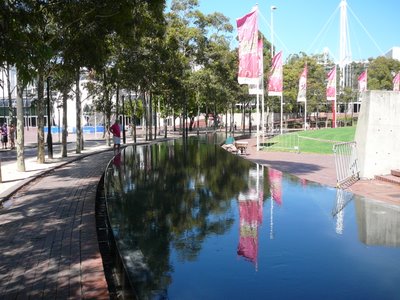
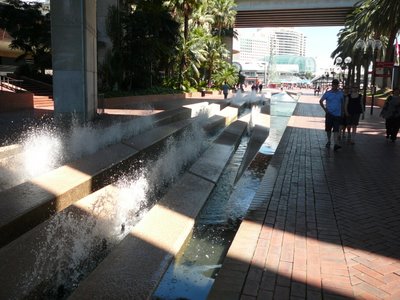
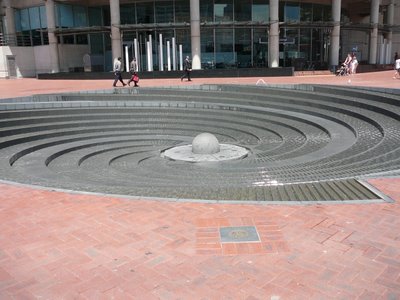
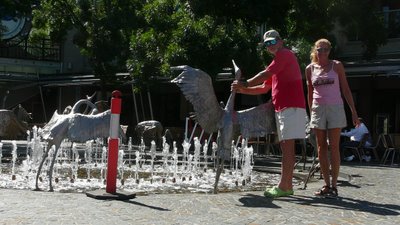
Now, Donald! behave yourself!
~~~~~~~
At the Maritime Museum we were very lucky that Australia's careful replica of James Cook's HMB Endeavor was in port and open for touring. 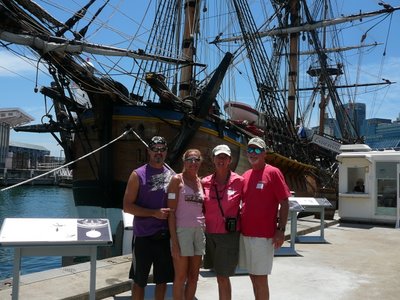
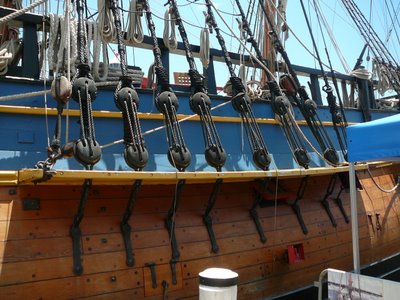
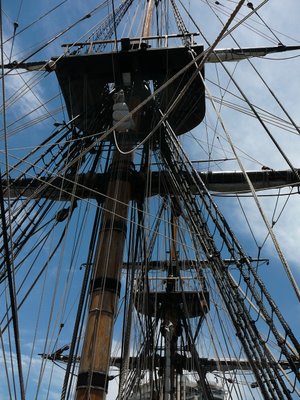
For us salty mariners, this was a thrill, as no one sails the Pacific without developing a deep respect for Cook. The Endeavor is not just a museum piece. It has sailed around the world, and one can book berths aboard for these trips as working crew and supernumeraries. The onboard docents were very knowledgeable and brought each corner of the ship alive, from the seats of ease in the main chains, the huge cook stove in the mess deck, 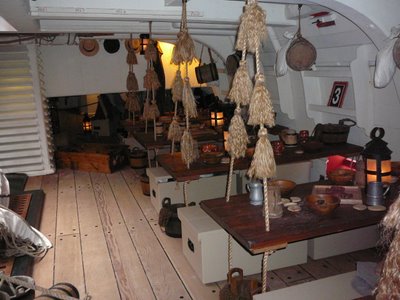
the crew hammocks swinging from the crossbeams,
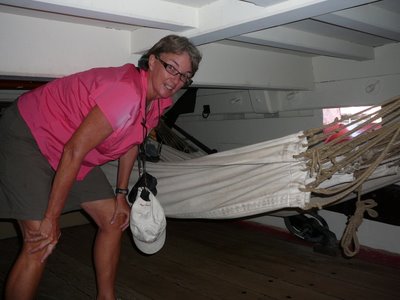
the incredible low pass-through where the old collier had been modified to accommodate Cook's crew and mission and where the young midshipmen lived, on aft to the quarters of Cook, his officers and the members of Joseph Banks' famous party. 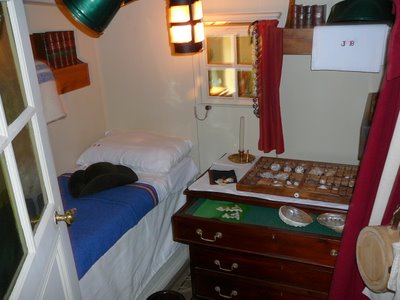
We did not see the hold below, which in the replica is where all the "mod-cons" (like the engine, generators and refrigeration) are hidden. But we did enjoy the deck and imagining that we at the helm.
We also toured the HMAS Onslow, a diesel submarine, and the HMAS Vampire, a destroyer, both retired from the Australian Navy. Both vessels also had docents aboard to help bring alive the way life had been, but what was kind of cool is that several of them had actually served aboard the ships when they were on active duty.
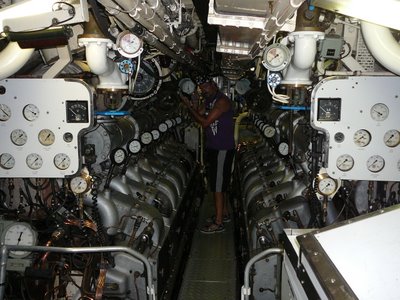
On Friday we spent the morning with a long walk to explore the neighborhood on both sides of the Cammeray inlet. It is amazing how some of these houses have been built, literally carving themselves out perches from solid rock. Across the head of the inlet and beneath the Northbridge Bridge is a park with a boat ramp, explaining the source of the motorboat wakes that jostled Procyon during the night.
In the afternoon we dressed up in our party clothes and took the bus to the Rocks neighborhood of downtown Sydney. (Sorry, everyone, I forgot to take the camera. Trust me...we all looked "flash!")
The Rocks was the site of the city's first settlement. It is a far cry now from those early, reportedly squalid days. Now it is a crowded canyon of a neighborhood with narrow streets, refurbished old buildings, trendy boutiques and hopping night spots. We had dinner at the Argyle, a converted warehouse and courtyard that has a peculiarly eclectic menu and is clearly a hot spot with the young professional crowd. By the time we left the courtyard was packed with after-work, Friday-night-before-Christmas partiers.
We walked from the Rocks past Circular Quay to the Sydney Opera House where we all had tickets for a Christmas concert at the concert hall.
The opera house up close is made of bone colored tiles, a surprise to me. Its location, out on a spit of land projecting from the Botanical Gardens is not quite as remote as all the pictures make it look. It is a fabulous spot, however, with the Harbor Bridge soaring overhead (we could see people climbing the girders at sunset!) and the busy harbor on three sides. When Randy and Sheri first arrived, they actually anchored for two nights just off the Opera House…until all the ferry wakes drove them out!
Our concert was fun. It featured the Opera House Christmas Chorus, the Opera House Christmas Orchestra, four personable opera soloists – Yvonne Kenney, David Hobson, Natalie Jones and James Egglestone, and a pops-style emcee named Simon Burke. The house was full, as one might predict, with families with lots of youngsters. Randy and Sheri had ordered tickets online for this concert six months beforehand. We ordered ours the week before. Randy and Sheri were in the fourth row, all the way to the right. We were in the fifth row, dead center. Go figure!
The program was all Christmas carols; some were performed by the soloists, some by the chorus, some with both, and some with the audience participating. There were no surprises -- appropriate since one isn't really looking for surprises on Christmas – until the end when they sang a song called "Six White Boomers," clearly a favorite with the crowd. "Six White Boomers" is Australia's answer to "Rudolph the Red-Nosed Reindeer." It is a Rolf Harris secular carol about a baby kangaroo looking for "his mummy" that Santa endeavors to help. But Santa gives his reindeer the day off and uses six white boomers (the boomers evidently being a species of large kangaroos) to pull the sleigh around Australia. If you want to add this song to your Christmas repertoire, it is easy to find and hear on the internet! Be careful; it's catchy! At the end of the concert, for an encore, the singers invited all the children up on stage for a reprise, which was executed with great spirit.
After the concert we hit another chocolate café for an après-concert snack, only to realize that we'd missed our last bus. Instead of a taxi, we caught a different bus which brought us to the very bridge to Northbridge we'd discovered that morning on our walk. Finding our way back through the maze of streets in the dark was a bit challenging, but as we were trying to make out a street sign (no street lights) we realized the "newel post" of the sign was actually a live owl! Adventures in suburbia!
For our last day in Sydney we had a get together with our friend Steve who with his wife Rachel now own the Beneteau 44 Apogee (formerly owned by our friends Joe & Julie of Palmlea in Fiji). Apogee is still languishing in a Vuda Point Marina cyclone pit because Steve got tied up with yet another project with a company from which he keeps trying to retire. As it has turned out, it is just as well they weren't out cruising, as family illnesses have totally distracted all their plans. We had originally thought our Sydney visit would be to Steve's company apartment, but Steve has been tied up across the continent in Perth much of the month.
However he returned in time to spend a day with us, carrying all four of us by car (what decadence!) through the city for an afternoon at Bondi, Sydney's other famous beach. 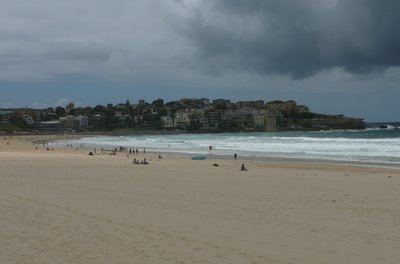
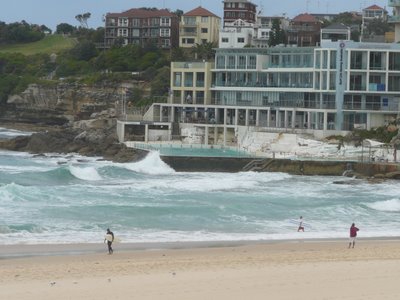
A major destination for surfers and backpackers, Bondi (pronounced Bond-eye) is the one you always read the shark stories about, and there is a big saltwater lap pool at the south end for those who don't want to risk it. The weather was chilly and blustery, so we all resisted temptation and made for a cosy little Greek sidewalk restaurant for lunch. Then we drove on down to the next beach in Coogee where we had refreshments at a waterfront pub.
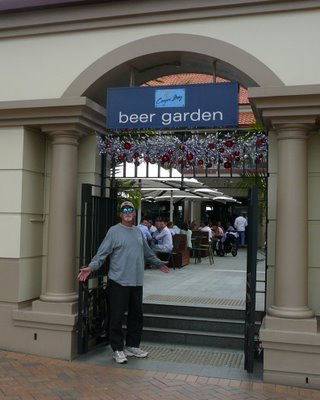
By this time, our Duracell battery packs were running down, and we looked forward to a quiet evening aboard Procyon after having packed up for our morning departure. Instead we ended up having an impromptu happy-hour get together (that lasted until 10pm, as I remember) with Steve and Truus of the catamaran Key of D, fellow alumni of the Port to Port Rally, who had just anchored in Cammeray inlet. It is a small, small world.
The next morning, Randy and Sheri very graciously helped us schlep our stuff UP the marina's 107 steps. You would think after five days it might be a less breathless endeavor, but I must say, with all the high living, any improvement was marginal. We caught our bus, made the connection at Wynyard Station like old hands (on Sunday morning the station was so deserted we were afraid it was closed!), and eased onto our flight with nary a hitch.
Instead of flying back to Maroochydore, however, we flew to Brisbane in order to collect Avior's Land Rover, kindly left with a parking service for us to pick up (Jim and Paula having flown to Scotland for two months.) What a great service this Andrew's Airport Parking was! A private enterprise, you call, they pick you up at the terminal, then drop you at your vehicle, and off you go. Fortunately for Don— facing the challenge of driving the five-speed manual Land Rover on the wrong side of the road from the wrong side of the car and shifting with the wrong hand – the exit from the lot was two simple left-hand turns straight on to the Bruce Highway. By the time we reached Mooloolaba about two hours later, he had it all down pat!
Labels: Cammeray, HMB Endeavor, James Cook, Marinas, Opera House, Procyon, Sydney
A quick look at the cruising guides of Queensland and New South Wales reveals that most of the anchorages with any kind of protection along Australia's East Coast (with the exception of the Whitsunday Islands) require crossing bars, but the complication is that bars and river courses themselves are comprised of shifting sand and thereby are known to rearrange themselves seasonally and with storms. Hence the importance of Queensland's annual guidebook Beacon to Beacon as well as Australia's very extensive volunteer coast guard and marine rescue organizations who stand by the radio to provide mariners with current weather and up-to-date bar crossing waypoints and information.
Randy of Procyon, being retired USCG, acquired the latest waypoints for our exit across the infamous Wide Bay Bar (WBB) at the bottom of the Sandy Straits and opposite Tin Can Inlet. We dutifully programmed these in only to have the CG Tin Can Bay post advise him the night before to follow the leads! Given that the waypoints called for a bit of a zigzag and the leads didn't, it made for a bit of suspense.
The ideal objective at WBB is to depart several hours before high tide in order to have the most water under the keel with the remaining rising tide providing a margin of error to lift you off should you make an error. Unfortunately, this means the tide is still coming in against you, slowing progress. We raised our anchor shortly after 0600 and motored our behind Procyon with a reefed main. This was a bit early for the tide, but with 61 miles to travel, we were anxious to get started so as to arrive in Mooloolabah in daylight. I'm not sure our early start with two knots against us achieved much head start over boats that left later, closer to slack tide!
The first bit was the diciest, following reverse leads (a range lined up over your shoulder) that directed us parallel to and quite close to waves breaking over the reef right off our starboard beam. Procyon tried following the waypoints which brought him into fairly shallow water. In the end, we both more or less split the difference in the directions. And, of course, just to add spice to the morning, in come a couple of fishing trawlers with their trolling booms lowered!
The next leg required a turn to starboard over the bar itself, theoretically lined up with a white light from a beacon on shore. This is another over the shoulder lead, but instead of two range markers, this was a white light that would show through a slot when you were correctly aligned. In the bouncy conditions and uncertain of what we would actually see in the daylight, trying to find this beacon with binoculars was not fun. But of course, once on it, it was an instance of "AHA!"
Then, as the water reached its shallowest (about 24 feet--not actually all that shallow in the end!), a black squall rolled over us making following any leads a questionable effort. It is just about now, when I was below following our course on the computer navigation and checking online weather, that Don's Dad called us on Skype to see if it was a good time to chat!
All this suspense, and in the endwe got across with little issue. Once the squall rolled onward, the seas settled right down and a vista of sand cliffs, presumably a geological extension of Fraser Island, unfolded on our right hand. Anticipating a wind shift from SE to East, both we and Procyon chose to pinch our way between Double Island Point and Wolf Rock. Unfortunately, the wind – SE @ 10 knots – never did back far enough out of the southeast to let us shut the engine down for more than a few hours. So our final sail was mostly a motorsail!
Our course kept us quite close to the coastline, which, for the first half day, was surprisingly undeveloped. The sand cliffs continued, becoming green-clad bluffs, yet nary a house showed, even though we saw 4WD vehicles driving up and down the beach. Only as we passed Noosa Head did that change. Suddenly the bluffs were densely packed with upscale neighborhoods. It was also about at Noosa Head that we saw our first and only pair of whales!
The increasing urbanization had us a bit worried that we might have chosen badly our finally berthing place. As we approached Mooloolaba, we spied a long white beach backed by ten-storey high rises already cast in shadow by the lowering sun. The entrance channel (no bar to speak of) was surprisingly out on the end of a spit. It was unsettling to look ahead as we entered to see what looked like a dead end. But a hard right turn led us down the channel of the Mooloolah River which parallels the beach for a mile or so past pile berths, fishing vessel berths and various marine services on the right and a handsome canal-based neighborhood of luxury homes and docks worthy of Ft. Lauderdale on the left.
Procyon, stopping over only for a couple of nights, continued upriver a few hundred yards to the crowded anchorage. Our marina – The Wharf – was right at the corner where the river course turns inland. Our friend Peter of Otama Song was waiting to catch our lines as we entered our slip (26*41.03S; 153*07.254E).
This e-mail was delivered via satellite phone using GMN's XGate software.
Please be kind and keep your replies short.
By the second evening, as gale warnings began to infiltrate the forecasts, the anchorage had twenty boats seeking shelter there! Amazing how big small anchorages can turn out to be, especially, of course, with local boats who come in knowing the extent of the good depths.
After a day of stripping the cockpit teak and other projects, we enjoyed a nice supper of homemade vegetable soup and settled in for a movie. We had just crawled into bed and begun to doze, when I jerked up with a shriek as cold rain drove in the aft port holes! Wind and rain are not supposed to come up the butt of anchored boats! Don leapt up to the cockpit to find that a squall had blown through bringing a 180-degree reversal to all the anchored boats. There are few things that can cause more trouble than 180-degree wind reversals like that as boat can be driven to sail right over the top of its anchor, potentially pulling it out. Friends in the Virgins Islands had gone on the reef in such a situation, so given the packed boats and the restricted area, nasty visions were dancing through our heads.
Fortunately, although there were a lot of flashing spotlights and a few boats had to re-anchor, the squall caused more tension than havoc. We sat up past midnight waiting for things to settle back down, and I'm not sure anyone ever fully relaxed again for fear of a repeat performance. In fact we did not have another. Oh, we had plenty of rain showers -- some heavy, most misty sprinkles -- and the wind managed to keep us sitting sideways to the current much of the time, making Don's teak project rather challenging. But all in all, once the wind settled into the southeast, Fraser Island gave us all plenty of protection during the five days the gale blew.
The morning after the squall we met the couple on the catamaran off our starboard side. A German couple, Goeth (sp?) and Sylvia came to offer us a ride to the beach since they had noticed our dinghy was on deck. This gave us a nice opportunity to check out the beach and take a stroll with interesting company through the piney forest on a stretch of the island's sand roads. The park signs advised us we might see dingoes, Australia's famous wild dogs, and offered advice on how to behave beginning with "leave them alone" and ending with "defend yourself assertively"! Which I presume is make yourself the alpha individual! We didn't see any dingoes. We did see no-see-ums. In the afternoon, several more boats came in to replace the several that had left. One of them was Procyon. Our second shore-side walk on Monday took us out along the drying flats beside the approach channel where we encountered armies of little crabs that clitter away from us across the sand like robot spiders before spiraling down into the sand when we get too close. Above us, two hawk/eagle types cycled from dead tree branches scanning the shoals for dinner, as well as a squawking white parrot-like bird that could be a local species or an escapee! Who knows!?
Our next few days were actually cruising at our most favorite. We mixed in boat projects, reading, writing, videos and socializing with chatting with family on Skype including a Birthday call to my sister in Vermont and a video session with Don's family including brother Greg, niece Brooke and her husband Nathan, and nephew Adam who were in Morristown with Don's parents for the sad occasion of the passing of Greg's father-in-law. As is often the case, Dick had been failing for some time, so his passing, hard as it always is, came as a release for all. We were sorry for the occasion, but happy to have to opportunity to "see" so much family that we hadn't seen in some time. We got to congratulate Brooke face to face on her pregnancy. Well, at least we thought it was face to face. We found out at the end of the half hour they hadn't been receiving our video! No one had mentioned it!
We'd been in Garry's for six nights before the weather began to ease up enough to think about poking our noses out. Larders were getting pretty thin for most of us as we had none of us imagined getting caught between ports for so long! With Internet weather available to all of us via our handy-dandy cellular broadband modems, we could not only follow the forecasts, but actually watch live data of wind speeds and radar rainfall, (invariably higher than the forecasts!) This led to as much group calculating as if we had been heading off on a major crossing. Well, with the infamous Wide Bay Bar to cross in order to get out to sea and tides to factor in, wind angle and distance to travel as we head south to Mooloolaba, there is plenty to calculate.
In the end, we raised anchor about 10:45 this morning to travel south to Inskip Point, from where one can decide whether or not to go out the Wide Bay Bar, something we are tentatively planning for tomorrow morning. Last minute decision-making had taken place over coffee and muffins aboard Whisper (which, no, folks, is not my old Whisper, but Duncan and Robin's lovely Hallberg Rassy 42!), and, in the end, Procyon and Tackless left, while Whisper stayed.
They must have known something they didn't share! Almost no sooner than we got out the gutter of Garry's anchorage than the rain returned. I built a teepee of sorts over my laptop which we needed in the cockpit for navigation down the narrow channel, especially when the rain made the ranges and marks hard to see. We had the tide with us, BUT that meant it was against the wind, which added up to choppy waves. It is a very bizarre sensation to make maybe 1.5 knots through the water, practically a standstill, yet be actually traveling 5+ over ground toward your destination! In the end, it took us just two hours to reach the Inskip anchorage (25*48S; 153*02E), and of course, the sky promptly cleared.
This very well could be our last open anchorage aboard Tackless II! Our objective tomorrow…or possibly Saturday if the wind doesn't back just a bit more out of the southeast tomorrow…is the Wharf Marina in Mooloolaba. Although it is said to be a lovely facility, it is also said to be in the midst of a tourist center. Marinas are never our first choice, but it is a necessary evil for showing the boat to prospective buyers. I guess we'll find out soon enough.
Meanwhile, a fat, buttery full moon rose over Wide Bay Bar this evening. Although the tidal currents continue to have their way with the boat with respect to the wind, we are so far sitting quite calmly. A huge shallow estuary opens to the south with the lights of boats willing to be pinned in by low tide twinkling from Pelican Anchorage. To the north are the sand bars and channels of the Sandy Straits down which we have come. To the west is Tin Can Inlet, which Avior calls home, and to the east is Wide Bay Bar. A veritable crossroads. It is a lovely spot.
This e-mail was delivered via satellite phone using GMN's XGate software.
Please be kind and keep your replies short.
Labels: Procyon
The first forty miles down Hervey Bay to the mouth of the Straits was easy sailing in open water in about 10 knots of wind just aft of the beam. However, once we passed the northern fairway beacon (25*08.41S; 152*49.57E), the trip became one of navigating carefully from beacon to beacon (or buoy to buoy), hence the name of Queensland's indispensable cruising guide. The northern section was still pretty easy going as we glided past Big Woody Island and Little Woody, places we'd thought we might stop overnight.
But it was early yet, barely noon, and we thought we could easily get further. Then came a later weather report with warnings of a trough and developing winds that would cycle right around! I swear, I have never been in a place where the weather reports change so quickly and so radically.
We had hoped to stop at Kingfisher Resort (www.kingfisherbay.com), a famous eco-resort often used by cruisers as a base for exploring Fraser Island. It has a restaurant, pool, plus rental jeeps and tours, and was a place we could have easily whiled away a few days. But not in northerlies. Of all the dozen or so anchorages shown along the western shore of Fraser Island, they are all, like Kingfisher, suitable for the prevailing easterly tradewinds only. Unfortunately the whole western edge of the straights is virtually inaccessible thanks to sand bars, shoals and mangrove islets, except where a few rivers and creeks penetrate. Most of these are not accessible for boats of any substantial draft, a major exception being the Mary River up which we could have like gone like Procyon did. But we are pretty focused on getting south to Mooloolabah where our agent has a couple of clients waiting to see the boat.
Studying the charts, we realized there were hardly any anchorages offering protection for the forecast northerlies, let alone for the westerly and southwesterly winds that would follow in the cycle back to southeast. Our best bet looked to be Bookar Island and the flooding tide helpfully accelerated our pace down the narrowing channel. However, as we looked further down the chart, we realized the channel beyond Bookar got very shallow in a short, snake-y section, and to get over THAT, we would need high tide. Since we were arriving at Bookar just before high tide, that meant high tide the next day would be an hour later, too close to sunset to lay the next and best possible anchorage – known as Garry's Anchorage – in a channel behind Stewart Island. Added to that, Bookar was already looking pretty exposed.
So, despite the already long day, we decided the prudent decision was to push on through the shallow section right then and make Garry's before sunset. We are very glad we did. The shallow section was quite shallow; we saw only 12 feet at several points and that was at high tide. Tides here regularly range up to two meters, which doesn't leave much left over. But I will say that the channel is well marked, and my electronic charts, in this case BSB charts leant to me by Jim of Avior and displayed on The CapN, were very accurate (better than CMap on MaxSea). Of course, we also had the Beacon to Beacon (which for some reason doesn't show depth!) as well as the great Queensland Maritime Safety Charts.
Also working in our favor was the fact that the effect of the tides on the Straits changes at its halfway point, Sheridan Flats, just opposite Bookar Island. In other words, the rising tide floods the straits from both ends, meeting in the middle, and likewise drains them in opposite directions. By passing Bookar and the flats at high tide, we let go the advantage of the incoming tide just in time to pick up the advantage of the outgoing tide ebbing southward! We scooted over the tricky section having wisely dropped the main, which we would have had to gybe back and forth for every twist and turn, and coasted into Garry's Anchorage about an hour before sunset.
Garry's Anchorage is a narrow semicircular channel running between Fraser Island and small, inset Stewart Island. It was not encouraging to see our friends Duncan and Robin on Whisper coming back out as we approached. According to the cruising guides, Garry's Anchorage can be entered from either the north or south opening, but Whisper had gone aground on their first try and only with luck managed to get off again before the tide went down any further! With our shallower draft (5' as opposed to 6'7"), we proceeded to give it a try. The channel was much narrower and shallower than we had imagined, but we found a spot between two power boats with about fifteen feet of water, depth enough to see us through even the full moon low tide next Wednesday if we stay that long!
After a settled night, the wind has been building as advertised. The power boats left on the early morning tide, but a number of sailboats have sought shelter in here from the building weather, including Duncan and Robin of Whisper who were willing to give it another go in the light of day. When the tide goes down, great expanses of sand flats are exposed all around us, and the wind in the trees behinds us sounds like rushing water. There are all sorts of birds around with unfamiliar calls, and the beach is littered with the debris of silvered limbs. Don is stripping the old Cetol from the cockpit teak that has looked like crap since Willie's crew pulled the tape from the paint job back in Fiji! And I, as ever, am working away on the computer.
Labels: Procyon
Actually, except for calmer seas, bottom soundings, and a few more seabirds, there was nothing to suggest we were approaching land of any size, let a lone a huge continent. Hervey Bay is a big wedge of water off the Queensland coast that is framed by Frasier Island, the worlds largest sand island. Again, no sight of it. The wind went light, and in our impatience to arrive, we fired up the engine. Night fell after another handsome sunset and still no hint of Australia. Finally about 8pm local time, we began to see some lights in the general direction of our waypoint.
The last leg of our trip, four miles up the approach channel of the Burnett River in the dark, was surreal. The channel is marked by pairs of powerful flashing green and red lights which leaves you feeling like you are landing a 747 on a runway, and because the channel extends well out into the bay, most of its length you still have water on either side! Once inside the lights were fewer and the dark darker. We actually passed the quarantine anchorage on the first go and then had to backtrack. Although the Port Bundaberg Marina just upriver was brightly lit, it actually made it harder to nose our way in to the small anchorage where three other boats already had the hook down. We shut down, toasted our arrival with a celebratory cocktail, and put our heads down, Don grousing that he would have to keep some kind of watch during the night in such close quarters. The next thing we knew, it was daylight!
This e-mail was delivered via satellite phone using GMN's XGate software.
Please be kind and keep your replies short.
Tomorrow mid-afternoon, if the wind holds, we should round the light at Break Sea Spit and enter Hervey Bay. It is another 40 miles from there to the channel entry to Bundaberg. It looks like we will arrive just after dark. Fortunately, Bundaberg is an easy, well-lighted approached and we will be able to motor right in to the quarantine anchorage when we arrive. And you know what that means? We will be able to get a good night's sleep in before facing customs and quarantine.
This e-mail was delivered via satellite phone using GMN's XGate software.
Please be kind and keep your replies short.
The next morning -- this morning -- the wind speeds were down and the seas were down quite a bit as well. Refreshed by some sleep yet faced with 400 miles still to travel without our big headsail, Don came up with a plan to replace the furling line with an old one and rehoist the sail. The first tricky part involved perching on the bow and winding the furling line back into the drum. The second tricky part was getting the many folds of the sail sorted out on a moving deck filled with dinghy and fuel jugs. In getting the sail down the day before in the big winds and seas, things had gotten a bit twisted up! The third tricky part was getting the sail rehoisted. The hero in this whole endeavor was the team of Otto and Perky who between them kept the boat steadily into the wind while the two of us were out wrestling things on the foredeck. Probably the biggest pain was trying to keep our harnesses clipped in while we needed to be first here and then there on the deck. We kept reminding ourselves that sailors used to change sails this way all the time in the days before roller furling! All went according to plan...well, the second time... and you never saw such pleased campers as these two Captains to have our sail back. We promptly shook out the reefs in the main and set the genoa and were off like a proper sailboat.
It's been grand sailing again today, the wind at a nice moderate 9-14 knots off the beam, while the large southern ocean swell runs by with a long period beneath us, lifting us smoothly from our port side and passing on away under us to starboard. This running swell is what I imagined we'd see all across the Pacific, but in fact it's the first one like this I remember.
By the way, we are not actually in the Pacific anymore. We are officially transiting the Coral Sea! So exotic!
This e-mail was delivered via satellite phone using GMN's XGate software.
Please be kind and keep your replies short.
Of course, you also don't want to have to deal with getting a flogging sail down in 20 knots and rough seas. And dark. Our soloution was to harden up the genoa (sheet it in for saiing) and then heave to and wait for daylight. Even in daylight, it wasn't a fun job, but we got the sail down and tied off on the starboard deck and soldiered on with reefed main, staysail, and old Perky. we needed the engine's help to point up sufficiently to get across a mid-ocean ridge we wanted to take at a certain place.
We should cross the ridge later this evening. the winds are backing into the south and are forecast to go southeast and the seas are already easing off a bit. That should make the last of our trip a little easier, letting us shake a reef or two out of the main and reach off the wind into Bundaberg. Right now, it looks like we might arrive sometime monday, but if not, it will be Tuesday morning. At this point I need to shift to using my computer for navigation (don't have a chip for Australia for the plotter), so once I do that, I MAY not be able to switch between the sat phone and the computer GPS. So if you don't hear from us, don't worry!
Really looking forward to Bundaberg!
The 2 Cs
This e-mail was delivered via satellite phone using GMN's XGate software.
Please be kind and keep your replies short.
Because it isn't now. We drove through the frontal barrier about 8am this morning. It was a relatively non-event, just a long line of clouds and rain, that was surprisingly narrow. On the back side the wind began to build out of the west, right on the nose as predicted. We motorsailed awhile and then finally fell off in hopes of sailing. The good news is the engine has been off all afternoon. The bad news is that it has been a bumpy ride in thewrong direction. However, as the sun sets, the wind is inching toward the south, and we are eeking our way back around on course.
Tomorrow the wind should be out of the south, a better direction, but we are forecast to get the big swells. Oh, joy!
This e-mail was delivered via satellite phone using GMN's XGate software.
Please be kind and keep your replies short.
Our day tomorrow is not likely to be as nice. The wind we are sailing under as I type is very light fom the northwest when typical wind is the se trades. A low way to the south of us is going to bring us headwinds tomorrow from the West and eventually some big swells and brisk southerlies. But for now, we'll enjoy another night of gentle seas and stars.
This e-mail was delivered via satellite phone using GMN's XGate software.
Please be kind and keep your replies short.
This e-mail was delivered via satellite phone using GMN's XGate software.
Please be kind and keep your replies short.
or Posts by Topic links in the upper left!
For our South Pacific posts prior to 2009 see
South Pacific Blog
November 2008
December 2008
January 2009
February 2009
March 2009
April 2009
Our USA Visits
Our Pre-Blog Logbook
The Blog Template is generated via PsycHo and is Licensed.
